Intel Unveils Lunar Lake Architecture: New P and E cores, Xe2-LPG Graphics, New NPU 4 Brings More AI Performance
by Gavin Bonshor on June 3, 2024 11:00 PM ESTBetter I/O: Thunderbolt 4, Thunderbolt Share, Wi-Fi 7 Included
Intel's developments in I/O and connectivity bring the current generation of connectivity to the Lunar Lake platform. Key highlights in terms of I/O, which is set for Lunar Lake, include native Thunderbolt 4 connectivity, the new Thunderbolt Share functionality, and the upgrade to Wi-Fi 7 wireless connectivity.
Thunderbolt 4 builds excellently on the foundation laid by Thunderbolt 3, which isn't new from a controller standpoint. It does offer enhancements in connectivity and bandwidth, and being internally opted for is the key difference here. Three Thunderbolt ports are now allowed for every laptop, making this feature very flexible and usable.
Thunderbolt Share is a new technology that will come with Lunar Lake. It allows multiple PCs to share screens, monitors, keyboards, mice, and storage across systems in a straightforward and fast manner at up to 60 frames per second. This is very important in collaborative environments, whereby sharing data is made easy and quick, thus improving workflow. When used in productivity tasks, the utility allows users to sync folders and has a drag-and-drop file-sharing function between PCs at high speeds.
Wi-Fi 7 is also integrated into the Lunar Lake platform, which Meteor Lake omitted regarding wireless connectivity. This multi-link operation feature of Wi-Fi 7 adds wireless signal integrity and reliability and increases throughput with less latency by duplicating packets across all links above. This implies smoother performance and better load balancing, even in demanding applications. The greatest benefit from Wi-Fi 7's new capabilities comes to the user when dealing with bandwidth-intensive tasks.
It also includes RF Interference Mitigation technology, where the DDR clock frequency is automatically tuned to minimize interference with Wi-Fi signals. This function saves 50% of throughput degradation caused by memory noise; thus, theoretically, it should uplift the performance of the entire wireless network. Another positive effect users can expect is robust connectivity, even in very demanding environments.
Intel's partnership with Meta goes further, tapping into this Wi-Fi 7 technology to enhance VR experiences. This further optimizes the video latency performance and reduces interference, thus making VR applications more seamless and engaging, at least from a wireless connectivity viewpoint. The new enhancements of Wi-Fi 7 offer high, reliable speed with low latency to meet the most challenging needs in VR applications.


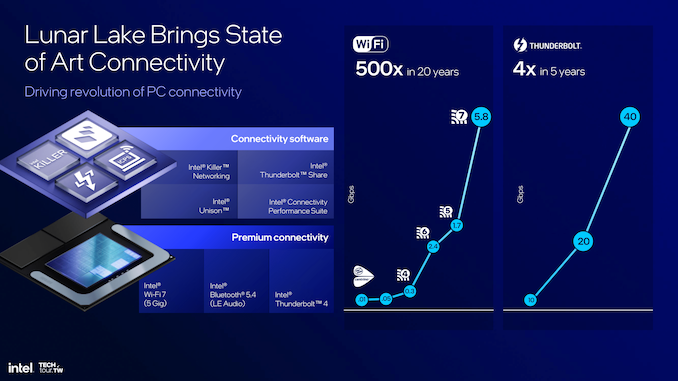
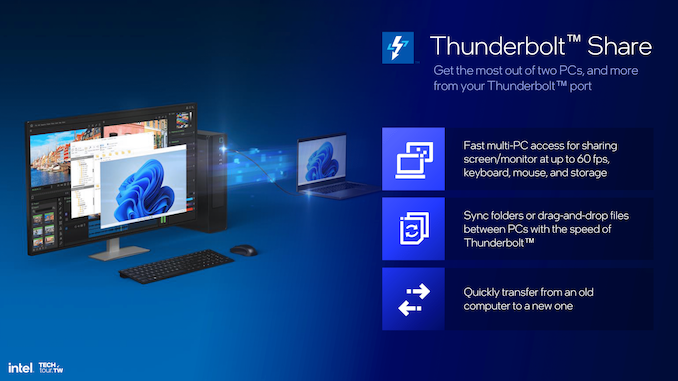
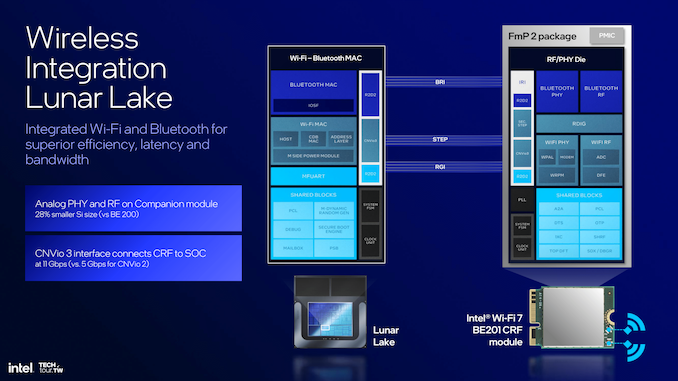
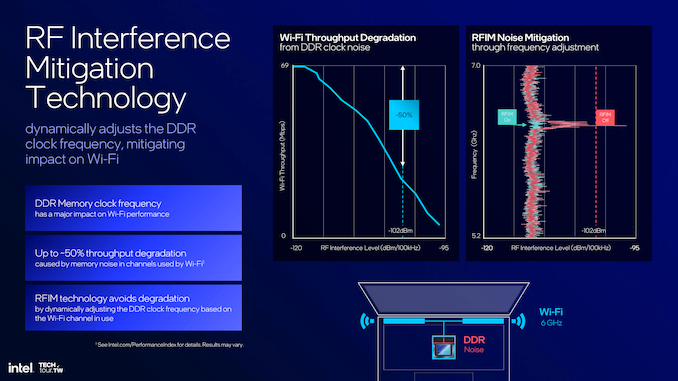
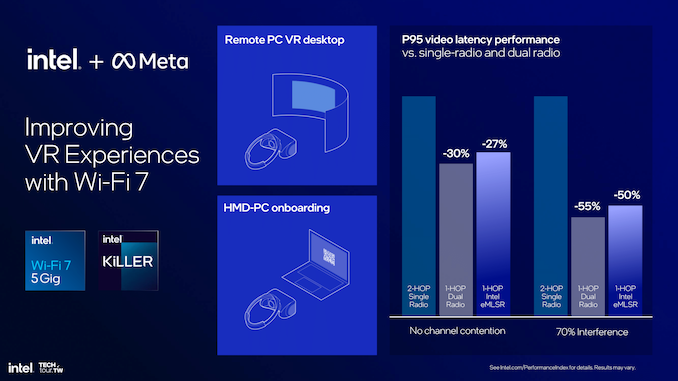








91 Comments
View All Comments
kwohlt - Tuesday, June 4, 2024 - link
20A is best thought of as an internal only, early sampling of 18A for use on the Compute Tile.But LNL differs from ARL in that its compute tile also contains the iGPU and NPU, making 20A not an appropriate choice. 18A would've been the node Intel would've needed, but that's not until next year (coincidently, LNL's direct successor, PNL, will use 18A for it's unified compute tile instead of TSMC) Reply
Blastdoor - Wednesday, June 5, 2024 - link
Or we could take it to mean that intel reserved a lot of N3B capacity and so figured they might as well use it. Like Apple, they will probably be looking to get off of N3B ASAP. While Apple moves to N3E, Intel will leap ahead to A18. ReplyThe Hardcard - Wednesday, June 5, 2024 - link
Barring newly announced delays, TSMC will hit volume on N2 in the same timeframe as volume on Intel A18. Apple’s move to N3E has happened. N2 in 2025. Replyrgreen1983 - Tuesday, June 4, 2024 - link
"This uplift is noticed, especially in the betterment of its hyper-threading, whereby improved IPC by 30%, dynamic power efficiency improved by 20%, and previous technologies, in balancing, without increasing the core area, in a commitment of Intel to better performance, within existing physical constraints."So hyper threading is bother present and improved, yet they disabled it? This seems non sensical Reply
meacupla - Tuesday, June 4, 2024 - link
From what I have read and seen from other tech sites, Intel disabled HT because it wasn't working properly with E-cores.Disabling HT improves performance and efficiency, because the E-cores get utilized, instead of sitting idle on low power loads. Reply
rgreen1983 - Tuesday, June 4, 2024 - link
I'm not asking why they disabled HT, we've known they were going to disable HT for some time. Disabling HT out of the box doesn't do anything because we've always been able to disable HT ourselves. I'm asking why they improved it if they are going to disable it, why waste a bunch of transistors and die area on a disabled feature? And if maybe the decision came too late to be removed, why brag about a thing that isn't even enabled? ReplyDrumsticks - Tuesday, June 4, 2024 - link
Unfortunately, this feels like word salad from Anandtech. I won’t speculate how or why it was left in, or why Anandtech is quoting a 30% gain in IPC that is nowhere in Intel’s slides or on other tech website coverage.They didn’t improve hyperthreading and then disable it. They removed the feature completely, and netted the die area and power savings from doing so. They probably also took a MT loss, but the die area and power savings could have been redirected to either better usage of the area for more performance, or just direct cost and efficiency savings. Intel’s hyperthreading was always a really inefficient way to gain a small amount of performance anyways. The actual side, published on Techpowerup’s dive, says removing hyperthreading saved them 5% perf/power, 15% perf/area, and 15% perf/power/area. That slide doesn’t appear to be published on Anandtech.
Essentially, they didn’t waste a bunch of transistors on a disabled feature - they did the obvious thing and physically removed the feature from the die. The description here is Anandtech’s fault, not Intel’s. Reply
rgreen1983 - Tuesday, June 4, 2024 - link
Thank you for your reply and the suggestion to check the techpowerup article. I would expect you are correct like the techpowerup article that HT was removed from the design and silicon, but I've also just read the pcworld lunar lake article which seems to suggest otherwise and amazingly has a slide not found in the techpowerup or anandtech articles.What I think might be going on is that lion cove still has HT in the design because Intel wants it for server chips, although I'd argue it's not necessary there either and by the looks of their recent all E core xeons the thread count sensitive clients should be running those anyways. That would explain why they might improve HT. If that is the case is there 2 lion cove designs, one with HT and another without? I just read the wccftech article which suggests this is the case, mentioning "variants" of lion cove.
Since this lion cove core for lunar lake is being made at tsmc, it makes sense they had to make a new design for their fab anyways so maybe they did remove HT, and wccftech says they removed TSX and AMX also. So the lion cove for Intel fab coming to arrow lake/xeon might have HT, will definitely have TSX and AMX, but they might still turn HT off and only enable for xeon.
Regardless yeah the anandtech mention of HT improvements here in relation to lunar lake seems off base. But I still think there is more Intel could clear up on HT status on die and whether there are multiple lion cove designs. Reply
Drumsticks - Tuesday, June 4, 2024 - link
I think they (techpowerup and pcworld) are both right. Per Tomshardware, commenting on Intel removing HT:"As such, Intel architected two versions of the Lion Cove core, one with and one without hyperthreading, so that the threaded Lion Cove core can be used in other applications, like we see in the forthcoming Xeon 6 processors."
I expect the LNL physical design lacks HT, as that's the only way to actually get the performance/area and performance/watt savings. But we'll probably see the version of Lion Cove with hyper threading show up in the Xeon world (although, to be honest, I'm not sure if it's worth it there given the efficiency losses), as well as on Arrow Lake, where higher performance in exchange for an efficiency loss tends to be an acceptable tradeoff for PC Enthusiasts.
The Tomshardware article also points out to me where Anandtech's article summary gets the 30% number: "Intel’s architects concluded that hyperthreading, which boosts IPC by ~30% in heavily threaded workloads, isn’t as relevant in a hybrid design that leverages the more power- and area-efficient E-cores for threaded workloads." - this is coupled with yet another slide that shows Intel quoting hyperthreading as a +30% throughput for +20% Cdyn.
In other words, I think *lunar lake* does not feature hyperthreading - it's physically non-present in the design. Lion Cove the P-Core microarchitecture, on the other hand, has two designs - one with HT physically present (in Arrow Lake and any Xeon SKUs - speculation), and one without (in Lunar Lake only).
On that note, it also implies two different Modules for e-core as well - one with the e-cores not present on the ring bus (in Lunar Lake) and one where it's connected to the ring bus like "normal"
- this being the config in Alder Lake and Raptor Lake (and this is presumably coming in Arrow Lake higher power laptop SKUs and the desktop) Reply
rgreen1983 - Wednesday, June 5, 2024 - link
Thank you for indulging me in this detailed discussion. I think you are right there are 2 lion cove designs. I don't think all the news outlets are aware of it. Reply